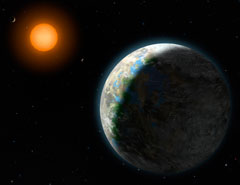Newly Discovered Planet May Have Water on Its Surface
A team of astronomers using a Keck telescope atop Mauna Kea on the Big Island of Hawaii have discovered a planet similar in temperature and likeness to the Earth. The planet called Gliese 581g is 20-light-years away in the constellation of Libra. Scientists say its mass indicates it is likely a rocky planet, and its temperature could indicate the possibility of liquid water on its surface. That, scientists say is an important step in the search for extraterrestrial life.

This artist's conception shows the inner four planets of the Gliese 581 system and their host star, a red dwarf star only 20 light-years away from Earth. The large planet in the foreground is the newly discovered GJ 581g, an Earth-size planet that orbits in the star's habitable zone. Artwork by Lynette Cook.
To discover the planet, the team looked for the tiny changes in the star’s velocity that arise from the gravitational tugs of its planets. They used 238 separate observations of Gliese 581 taken over a period of 11 years.
The planet, which is probably 30 percent larger than Earth, orbits a relatively small star. It’s mass is three to four times that of Earth, and orbits its star in just under 37 Earth days. It is one of six known planets orbiting the star.
The discovery was made by a team of astronomers that includes the University of Hawaii’s Nader Haghighipour.
“By determining the orbit of this planet, we can deduce that its surface temperature is similar to that of Earth,” said Haghighipour. This means that at least some of any water on the surface of the planet and in its atmosphere will be in liquid form rather than ice or vapor.
Haghighipour said that the team is keeping tabs on many nearby stars using the Keck Observatory. “As we collect more and more data about how these stars are moving, we expect to find many more planets with potentially Earth-like conditions,” he said.
(Posted by Wendy Osher; supporting information courtesy University of Hawaii Institute for Astronomy)










